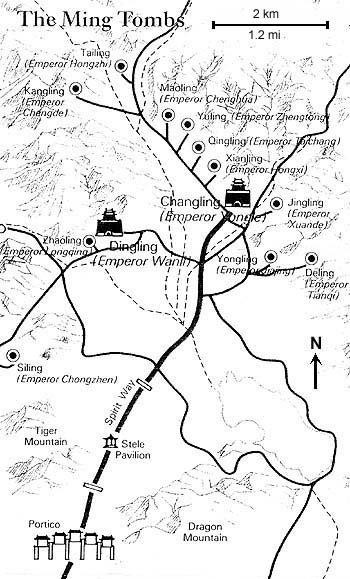
Ming Tombs (Shisanling)
NW of Beijing
The Ming Tombs, final resting place of thirteen of the sixteen emperors1 of the Ming dynasty, are located 42 km northwest of Beijing, in a mountain valley just below the Great Wall. The tombs are approached from the south by a five-arched gate, beyond which a long "spirit road," lined with men and animals, leads to the burials. Much as today, visitors from Ming times onward would pass under a five-gated stone portico, dismount at another gate beyond the portico, pay their respects at the Shisanling Stele, and then walk a mile or two along the spirit road to see the burials.
The tombs are nestled in a valley, according to fengshui principles, and surrounded by groves of cypresses. Each emperor was buried underneath a tumulus (large earthen mound). His tomb was preceded by a sacrificial hall and "spirit tower" and surrounded by subsidiary tombs for wives, concubines, and princes. There were also houses and working quarters, amounting to a rather substantial town, for the many living people - priests, caretakers, and supporting personnel - who maintained the tomb and performed the prescribed Confucian2 rites and sacrifices on behalf of the deceased emperor. The valley as a whole was surrounded by a wall that was garrisoned by soldiers from a nearby town.
Of the actual burials, only one, Dingling, has been opened and excavated. The others currently (2006) lie undisturbed beneath the soil, although the above-ground halls of Changling and Zhaoling have been restored, and the grounds of all the tombs are visitable. Confusingly, the artifacts unearthed from Dingling are displayed at Changling rather than at Dingling from whence they came. The sequence of photographs in the following pages proceeds from the portico north to Emperor Yongle's3 Changling, the first and greatest tomb in the valley.

